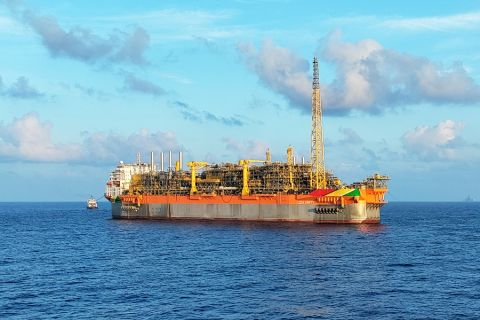To be sure a formation will produce commercial quantities of hydrocarbon, operators must be able to determine the hydrocarbon composition, its mobility, and its pressure. Traditionally this information is derived from formation test tools deployed on wire-line or in some cases with LWD tools. Until now, these devices had limitations, specifically in viscous crude, in low-permeability formations, or in unconsolidated formations. Many of these formations were deemed untestable.
A new formation testing module, the Saturn 3D radial probe, extends the operating range of the MDT modular formation dynamics tester to extremes, enabling high-quality formation fluid samples, precise formation pressures, and in situ downhole fluid analysis in formations and borehole conditions previously impossible to test.
Beside those applications previously mentioned, the new tool can deliver fluid pressure-gradient determination, far-field permeability measurement, and anisotropy determination. These answers are invaluable in production test design optimization. The 3-D radial probe module complements the modular formation dynamics system while extending its capability.
With its four elliptical 3-D radial probes, spaced at 90° intervals around the inflatable packer element, the tool can achieve and maintain a hydraulic seal at up to 8,000 psi differential pressure. The industry’s largest surface flow area probes (cumulative surface flow area slightly less than 90 sq in.) can quickly dispose of mud filtrate in the near wellbore pore space and produce uncontaminated formation fluid for in situ characterization and sampling.
Low fluid mobility challenges
In a deepwater well offshore West Africa, conventional formation testers had been unable to obtain or analyze samples of formation fluid due to extremely low fluid mobility. Lowest fluid mobilities ranged from 0.1 mD/cp to 0.01 mD/cp.
The four large flow-area probes were able to quickly establish a seal and deliver rapid cleanup of contaminants. All formation pressure and mobility tests were successfully achieved at extremely low mobilities, and downhole fluid analysis samples were captured in mobilities as low as 2 mD/cp.
Unconsolidated sandstone threatened plugging
In Mexico a friable sandstone was saturated with ultrahigh viscosity 7.5°API oil. Moreover, attempting to test the zone with high drawdown risked extreme sanding with subsequent plugging of the test tool. Previously, the only way the operator could test the reservoir was to case and cement the wells so each zone could be perforated and flow-tested using a very costly and time-consuming coiled-tubing solution.
Using the 3-D radial probe with its high flow area allowed openhole testing of each formation at low draw-down with no sanding. The four self-sealing radial probes supported the unconsolidated sandstone, while uncontaminated samples were analyzed and captured in pressure-volume-temperature sample chambers. Each probe is equipped with a sandface filter to screen out any sand grains from entering the flowline. Another feature of the tool proved extremely valuable in this case. The boreholes had 12% ovality, yet the compliant 3-D probe packer was able to obtain and maintain its seal by conforming itself to the shape of the borehole.
Indeterminate carbonate pay zone
In a low-permeability Middle East dolomite, the operator was unable to confirm the presence of commercial hydrocarbons with well logs because the formation resistivity was as low as 0.7 ohm-m, largely due to contamination by high-chloride, water-based mud. The operator chose to test the formation and acquire samples, but because of adverse hole conditions testing was limited to four hours per zone. Even with an extra-large diameter conventional probe, it was not possible to get clean, interpretable samples in the allotted time. However, the large-area 3-D probe increased flow rate by 650% over that of the conventional probe, allowing for faster cleanup with less drawdown. Both the downhole fluid analyzer and the fluid samples retrieved confirmed 60% to 70% oil with mobility as low as 1.5 mD/cp. The ratio of flow rate to pressure drop was 19 times better than that of the conventional probe.
Using the 3-D radial probe, the oil-bearing portion of the reservoir was identified and thoroughly characterized. The oil/water contact was clearly identified. This completely satisfied the needs of the operator within the previously determined time limits.
Fully combinable with the modular formation dynamics tester tool, the 3-D radial probe module allows successful fluid testing and analysis and fluid sample acquisition under the most extreme borehole and formation fluid conditions. Heavy, low-mobility oil and fluids whose bubblepoints and dewpoints are at or near reservoir pressure pose no problems for the integrated tool system. Because the storage effect is minimized in the tool, fast flow regime identification is possible.
The tool has been thoroughly tested worldwide under a wide variety of conditions and has outperformed all conventional probes while enabling successful tests in wells where conventional tests would not have even been attempted.
Recommended Reading
E&P Highlights: Feb. 26, 2024
2024-02-26 - Here’s a roundup of the latest E&P headlines, including interest in some projects changing hands and new contract awards.
Exxon Mobil Green-lights $12.7B Whiptail Project Offshore Guyana
2024-04-12 - Exxon Mobil’s sixth development in the Stabroek Block will add 250,000 bbl/d capacity when it starts production in 2027.
Exxon Ups Mammoth Offshore Guyana Production by Another 100,000 bbl/d
2024-04-15 - Exxon Mobil, which took a final investment decision on its Whiptail development on April 12, now estimates its six offshore Guyana projects will average gross production of 1.3 MMbbl/d by 2027.
CEO: Continental Adds Midland Basin Acreage, Explores Woodford, Barnett
2024-04-11 - Continental Resources is adding leases in Midland and Ector counties, Texas, as the private E&P hunts for drilling locations to explore. Continental is also testing deeper Barnett and Woodford intervals across its Permian footprint, CEO Doug Lawler said in an exclusive interview.
For Sale, Again: Oily Northern Midland’s HighPeak Energy
2024-03-08 - The E&P is looking to hitch a ride on heated, renewed Permian Basin M&A.





